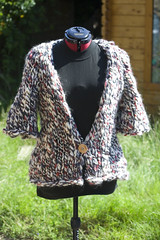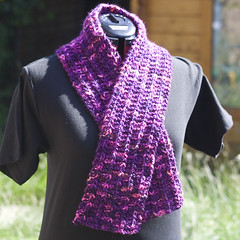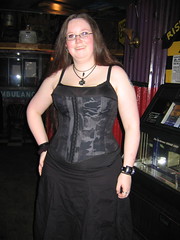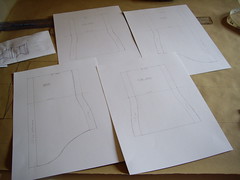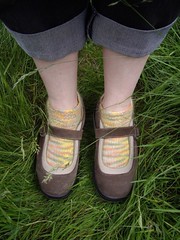We finally got around to watching This Is England last night. I’ve been wanting to see the film for a long time, even though I already knew that it would be very difficult for me to watch. I’m not a big fan of racism, violence and extreme right wing politics, and those are the main topics of the film.
I’m not well-enough informed, socially, politically, or historically, to be able to talk about the film from those points of view, but what I do want to talk about is the clothes.

If there was one style of clothing which I truly wish I could wear but never have done, it would be this. Probably with jeans rather than mini skirts, but there’s something about this style which really appeals to me. I do own two Ben Sherman shirts, although they’re both prints, not checks. I’ve owned countless pairs of Doc Martens over the past twenty years, and despite the fact that Paul makes a face every time I show him photographs, there’s something extremely appealing to me about that hair cut. I do remember going out in the 1980s wearing a white shirt, black braces and a trilby, but for all the Doc Martens I’ve ever worn, I’ve never even been tempted to buy a tall cherry red pair.
When I was a Goth, dressing was easy. Everything black, lots of eyeliner, pointy shoes or the most enormous boots I could find. For all the protestations of “individuality”, what I liked best about being a Goth was having a group that I demonstrably belonged to, and I demonstrated it with my clothes. I like dressing up, I like the music, I like bats and skulls and books about vampires. It was easy for me to be a part of that group.
But dressing like a skinhead? That’s much more problematic. When I was reading The Way We Wore, last year, it touched on a lot of the things I’ve been trying to think about coherently while I was watching the film.
The original skinheads, in the late 1950s, had nothing to do with racism and violence. Theirs was an inclusive culture, born directly out of living and working with Caribbean immigrants who’d recently started arriving in the UK. Without these groups mingling together, we’d never have had Ska and 2 Tone, and bands like Madness or The Specials. But, the economic climate in those times was terrible, and the feeling did develop that other people were coming into “our” country and taking “our” jobs and “our” houses. Racially-motivated violence was breaking out all across England, predominantly in working-class communities, and this escalated into the Notting Hill riots of 1958.
The same thing effectively happened during the early 1980s. The country was faced with record levels of unemployment, along with an increase in immigration from countries such as Pakistan. The Falklands war began in 1982, and with it came a surge of popularity for far right wing politics. The Teddy Boys, who’d been the main antagonists during the Notting Hill riots, had been all but forgotten, but skinhead, punk and the National Front became inextricably linked in the public image until the skinhead look unequivocally represented a uniform of racism and hatred.
There are countries where the skinhead image still represents what it did during the 1950s – a working-class background and the love of a certain type of music. Hel Looks, a website which documents street fashions in Sweden, demonstrates that the skinhead look is still popular. In parts of America, skinhead is more closely linked with 1970s punk.
I’ve worn some unusual clothes over the years. As a Goth, people were forever telling me to “cheer up”, or reminding me that “it’s not Hallowe’en”. Having pink hair is apparently a license for people to point and shout at me in the street. I’m more than used to being stared at because of my clothes, and not always in an appreciative manner.
But to walk down the street, in England, wearing tall cherry reds, jeans, braces and a feather cut? However much I might enjoy the style and the music, I just couldn’t do it.
(More here, from Wikipedia.)
Like this:
Like Loading...




